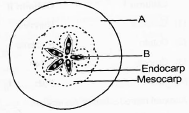A typical angiosperm anther is bilobed with each lobe having two theca i.e. dithecous. Theca is separated often by:
(1) A longitudinal groove running lengthwise
(2) A longitudinal groove running breadth wise
(3) A transverse groove running breadth wise
(4) A transverse groove running lengthwise
(1) A longitudinal groove running lengthwise
(2) A longitudinal groove running breadth wise
(3) A transverse groove running breadth wise
(4) A transverse groove running lengthwise
Following are four statements how many of them are correct?
a. The anther is a tetragonal structure, with four microsporangia at corners, two in each lobe.
b. Microsporangia develops further and becomes pollen sacs.
c. A typical microsporangia is surrounded by four-layered wall, 3-protective and 1 nutritional.
d. The nutritive layer is densely cytoplasmic and with more than one nucleus
Options :
1. 3 2. 4
3. 2 4. 1
When anther is young a group of compactly arranged homogenous cells are present in centre it is known as
(1) Sporogenous tissue
(2) Potential pollen mother cell
(3) Both 1 and 2
(4) Conjunctive tissue
Which of the following structure is not associated with protection and dehiscence of anther?
1. Tapetum
2. Epidermis
3. Endothecium
4. Middle layer
Which of the following statement is not correct for pollen grain?
(1) It represents male gametophyte
(2) It is a spherical structure, about 25-50 micron in diameter
(3) Pollen grains are rich in nutrients
(4) In family rosaceae, leguminoseae and solanaceae pollen lose viability in 30 minute
Look at the diagram given below and answer appropriately

(i) Since ___A___ is associated with fruit, it is called as ___(i)___ .
(ii) Since ___B___ is present, fruit cannot be called as ___(ii)___ .
1. A - Pericarp, (i) - True fruits
2. B - Seed, (ii) - Ex-albuminous
3. A - Thalamus, (i) - True fruit
4. B - Seed, (ii) - Parthenocarpic
A typical anther shows
a. Two lobes with two theca each
b. Each lobe as dithecous
c. All cells in a given microsporangium as potential PMC
d. Thousands of microspores per microsporangium
Out of these statements :
1. b is incorrect
2. a and b are correct
3. c and d are incorrect
4. a, b, c and d are correct
Find correct match
| Column I | Column II |
| a. Thick and swollen | i. Castor cotyledons |
| b. Unused endosperm | ii. Legumes in mature seed |
| c. Unused nucleus in | iii. Cashew nut seed |
| d. Thalamus contributes to fruit formation | iv. Beet |
| a | b | c | d | |
| (1) | iii | iv | ii | i |
| (2) | i | iii | iv | iii |
| (3) | ii | i | iii | iv |
| (4) | ii | i | iv | iii |
Arrange the following stages of microspore development into pollen grain, in correct sequence
1. b, c, d, and a
2. b, d, a and c
3. a, c, b and d
4. b, a, d and c
Identify the statements that are true for anemophilous flowers
a. Pollen grains are light and non-sticky.
b. They possess well exposed stamens.
c. They have large coloured flowers.
d. They have single ovule in each ovary.
e. Flowers produce nectar and scent.
1. a, b and e
2. a, b and d
3. b, c and e
4. c, d and e







